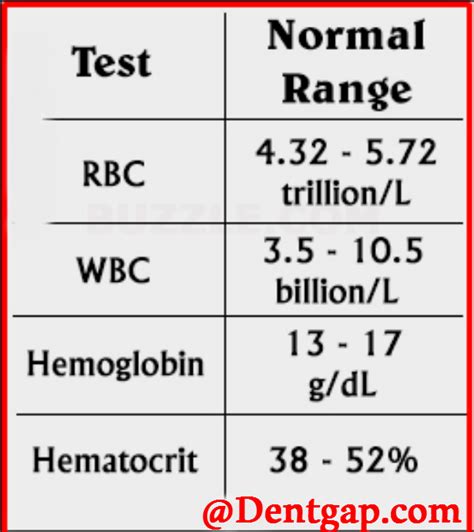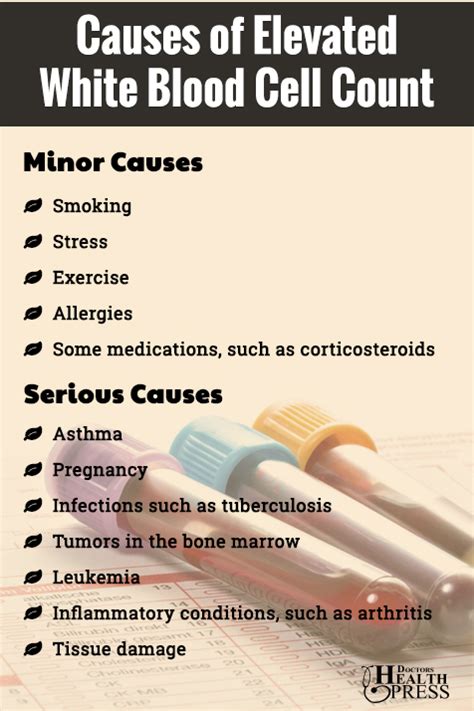Intro
Discover the normal range for White Blood Count (WBC), understanding Leukocyte levels, and learning about Neutrophils, Lymphocytes, and other immune cells to diagnose health issues accurately.
The white blood count, also known as the leukocyte count, is a crucial component of a complete blood count (CBC) test. It measures the number of white blood cells (WBCs) in the blood, which play a vital role in the immune system. The normal range for white blood count varies slightly depending on the laboratory and the individual's age, but generally, it ranges from 4,000 to 11,000 cells per microliter (μL) of blood. Understanding the white blood count normal range is essential for diagnosing and monitoring various health conditions.
A white blood count test is often performed to assess the body's immune response, detect infections, and monitor the effectiveness of treatments. An abnormal white blood count can indicate a range of health issues, from mild infections to severe diseases like leukemia. Therefore, it is essential to understand the normal range and the factors that can influence white blood count results. In this article, we will delve into the details of white blood count, its normal range, and the factors that can affect it.
The white blood count is influenced by various factors, including age, sex, and overall health. For example, newborns and infants have a higher white blood count than adults, while pregnant women may experience a slight increase in white blood count during the second and third trimesters. Additionally, certain medications, such as corticosteroids and antibiotics, can affect white blood count results. It is crucial to consider these factors when interpreting white blood count results to ensure accurate diagnosis and treatment.
Understanding White Blood Cells

The white blood count measures the total number of white blood cells in the blood, but it does not provide information about the specific types of white blood cells. To determine the types and proportions of white blood cells, a differential count is performed. This test helps to identify any abnormalities in the white blood cell count and can aid in diagnosing specific health conditions.
White Blood Count Normal Range

- Newborns (0-1 month): 9,000-30,000 cells/μL
- Infants (1-12 months): 6,000-17,000 cells/μL
- Children (1-5 years): 5,000-15,000 cells/μL
- Children (6-12 years): 4,500-13,000 cells/μL
- Adults: 4,000-11,000 cells/μL
It is essential to note that these ranges can vary slightly depending on the laboratory and the individual's overall health. A white blood count outside of the normal range can indicate a range of health issues, from mild infections to severe diseases.
Factors Affecting White Blood Count

- Age: White blood count tends to decrease with age.
- Sex: Women tend to have a slightly higher white blood count than men.
- Pregnancy: White blood count can increase during pregnancy, particularly during the second and third trimesters.
- Medications: Certain medications, such as corticosteroids and antibiotics, can affect white blood count results.
- Infections: Bacterial, viral, and fungal infections can cause an increase in white blood count.
- Inflammatory diseases: Conditions such as rheumatoid arthritis and lupus can cause an increase in white blood count.
- Stress: Physical and emotional stress can cause an increase in white blood count.
- Sleep: Lack of sleep or poor sleep quality can affect white blood count results.
It is crucial to consider these factors when interpreting white blood count results to ensure accurate diagnosis and treatment.
Interpreting White Blood Count Results

- Normal white blood count: 4,000-11,000 cells/μL
- Low white blood count (leukopenia): <4,000 cells/μL
- High white blood count (leukocytosis): >11,000 cells/μL
A low white blood count can indicate a range of health issues, including:
- Bone marrow failure
- Cancer
- Infections
- Inflammatory diseases
- Medication side effects
A high white blood count can indicate:
- Infections
- Inflammatory diseases
- Allergic reactions
- Stress
- Medication side effects
It is essential to consult a healthcare professional to interpret white blood count results and determine the underlying cause of any abnormalities.
Health Conditions Associated with Abnormal White Blood Count

- Infections: Bacterial, viral, and fungal infections can cause an increase in white blood count.
- Inflammatory diseases: Conditions such as rheumatoid arthritis and lupus can cause an increase in white blood count.
- Cancer: Certain types of cancer, such as leukemia and lymphoma, can affect white blood count results.
- Bone marrow disorders: Conditions such as aplastic anemia and bone marrow failure can cause a low white blood count.
- Autoimmune disorders: Conditions such as HIV/AIDS and autoimmune hepatitis can cause a low white blood count.
It is essential to consult a healthcare professional to determine the underlying cause of any abnormalities in white blood count results.
Monitoring White Blood Count

- Frequency: White blood count should be monitored regularly, depending on the individual's health condition and medical history.
- Timing: White blood count should be monitored at the same time of day, as white blood count can vary throughout the day.
- Laboratory: White blood count should be monitored at a reputable laboratory, using standardized testing procedures.
It is essential to consult a healthcare professional to determine the best approach for monitoring white blood count and to interpret results accurately.
Conclusion and Next Steps

We invite you to share your thoughts and experiences with white blood count in the comments section below. If you found this article informative, please share it with your friends and family to help them understand the importance of white blood count. Join the conversation and let's work together to promote healthy living and disease prevention.
What is the normal range for white blood count in adults?
+The normal range for white blood count in adults is between 4,000 and 11,000 cells per microliter (μL) of blood.
What factors can influence white blood count results?
+Several factors can influence white blood count results, including age, sex, pregnancy, medications, infections, inflammatory diseases, stress, and sleep.
What does a low white blood count indicate?
+A low white blood count can indicate a range of health issues, including bone marrow failure, cancer, infections, inflammatory diseases, and medication side effects.
How often should white blood count be monitored?
+White blood count should be monitored regularly, depending on the individual's health condition and medical history. The frequency of monitoring will vary depending on the individual's specific needs.
What should I do if I have concerns about my white blood count?
+If you have concerns about your white blood count or overall health, consult a healthcare professional for personalized advice and guidance.
